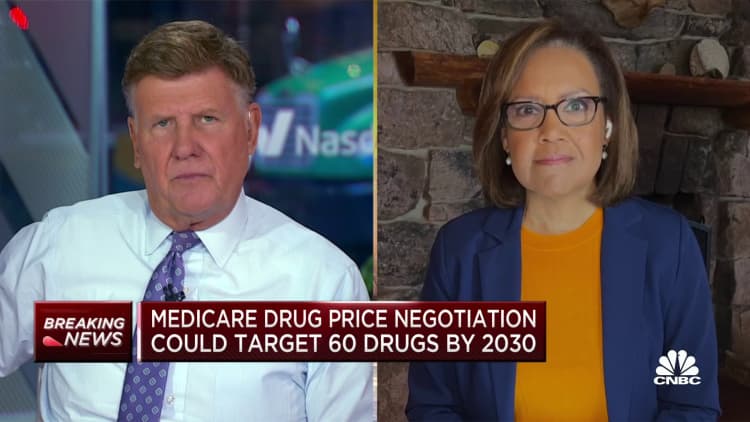A new law is poised to cap seniors' prescription drug costs covered under Medicare, starting in 2025.
But retirees may be in for a shock next year — significantly higher Medicare Part D premiums for prescription drug coverage.
The cost of the average premiums will rise between 42% and 57% in 2024 compared to 2023 in five states with the largest populations of individuals over 65 who are on Medicare, according to a new analysis by HealthView Services, a provider of health care cost data.
That represents an increase ranging from $128.32 to $380.96 from 2023 to 2024, according to the firm. The calculations are based on three of the largest Medicare providers in each state.
The five states include California, Florida, New York, Pennsylvania and Texas.
The increased costs come as new changes put into law through the Inflation Reduction Act will lower the out-of-pocket maximum drug costs for seniors to $2,000 in 2025, down from more than $7,000 in 2023.
Other changes put into place with the legislation — such as a $35 monthly cap on insulin and access to free vaccines — have already gone into effect.

Insurers may pay higher costs due to the higher out-of-pocket limits, and higher premiums is a way of getting beneficiaries to share that burden, according to Ron Mastrogiovanni, founder & CEO of HealthView Services.
Today, the federal government picks up 80% of the more than $7,000 maximum spent on Part D prescription drugs, while insurers cover the remaining 20%, Mastrogiovanni said.
When the out-of-pocket max drops to $2,000, insurers will cover 60% to 80% of the costs, with the federal government picking up the difference.
About a quarter of Medicare Part D beneficiaries are expected to go over that $2,000 limit.
"The insurance company has to do to do something to make up for that loss, given the number of people that may go over," Mastrogiovanni said.
"Therefore, we who are on Medicare Part D are going to be sharing in that cost," he said.
Research from KFF, an independent provider of health policy research, has also found monthly premiums for Part D will be "substantially higher" in 2024. The national average monthly Part D premium is projected to increase 21% in 2024 to $48, up from $40 in 2023, according to KFF.
Those monthly premiums may increase again in 2025 as the new policy takes effect, according to Juliette Cubanski, deputy director of KFF's program on Medicare policy.
"It's possible that between 2024 and 2025 we could also see another round of premium increases again," Cubanski said.
That would be a bigger concern for people who are in standalone drug plans, she noted, than for people who are in Medicare Advantage plans, which have rebates available that can help shield enrollees from higher premiums costs.
Higher Medicare costs to offset Social Security COLA
Rising Medicare Part D premiums come as retirees will receive a much smaller Social Security cost-of-living adjustment in 2024 — 3.2% — compared to the 8.7% boost to benefits they received in 2023.
The average Social Security beneficiary will get about $700 more per year in 2024 through the cost-of-living adjustment, estimates Michael Daley, director of marketing at HealthView Services.
But higher costs for next year, particularly with regard to Medicare, may consume most of that increase.
"If you are on a high-end Part D plan, on average, 54% of your cost of living increase in Social Security is going to go for paying the additional costs that you're going to have to cover for Part D premiums," Daley said.
That's as standard premiums for Medicare Part B, which covers services from doctors and other health care providers, will increase by $9.80 per month to $174.70 in 2024, from $164.90 per month this year. High-income beneficiaries will pay higher premiums.
How to manage rising Medicare costs
With Medicare open enrollment available through Dec. 7, beneficiaries may take steps now to mitigate the higher expected costs for next year.
Aside from premium changes, plans may also shift the prescription drugs they cover and the cost-sharing amounts they charge, Cubanski noted.
"It's always good advice during this open enrollment period for people, even if they're happy with the coverage that they have, just to take a look at other options and see whether they might be able to get better coverage," Cubanski said.
Finding the best coverage for your budget can help you avoid having to cut back on prescription drugs or doctors' visits, according to Mastrogiovanni.
Medicare beneficiaries should also be aware that a 12% annual premium penalty applies for those who don't sign up for prescription drug coverage at age 65, he said.
"Even if you're not on any drugs and you're going into retirement, I strongly recommend purchase the least expensive plan you can," Mastrogiovanni said.





